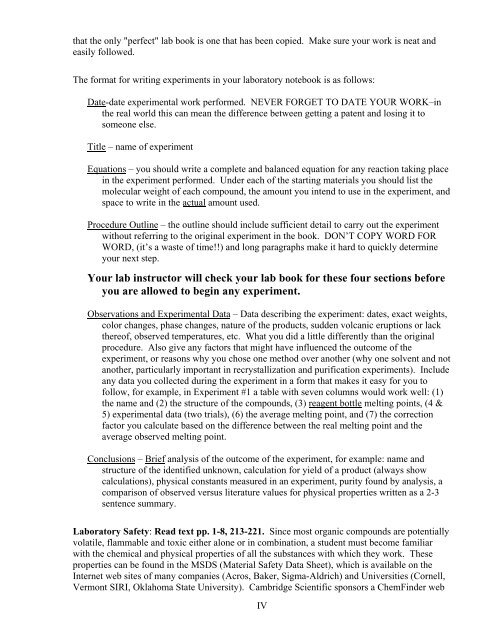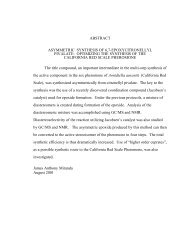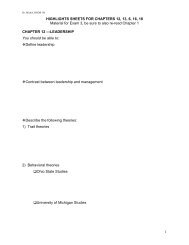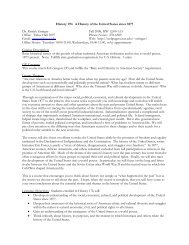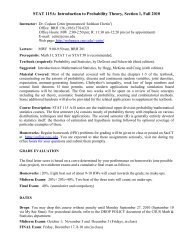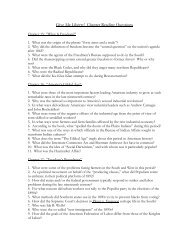I CHEMISTRY 25 Organic Chemistry Laboratory I Fall 2006 ...
I CHEMISTRY 25 Organic Chemistry Laboratory I Fall 2006 ...
I CHEMISTRY 25 Organic Chemistry Laboratory I Fall 2006 ...
You also want an ePaper? Increase the reach of your titles
YUMPU automatically turns print PDFs into web optimized ePapers that Google loves.
that the only "perfect" lab book is one that has been copied. Make sure your work is neat andeasily followed.The format for writing experiments in your laboratory notebook is as follows:Date-date experimental work performed. NEVER FORGET TO DATE YOUR WORK–inthe real world this can mean the difference between getting a patent and losing it tosomeone else.Title – name of experimentEquations – you should write a complete and balanced equation for any reaction taking placein the experiment performed. Under each of the starting materials you should list themolecular weight of each compound, the amount you intend to use in the experiment, andspace to write in the actual amount used.Procedure Outline – the outline should include sufficient detail to carry out the experimentwithout referring to the original experiment in the book. DON’T COPY WORD FORWORD, (it’s a waste of time!!) and long paragraphs make it hard to quickly determineyour next step.Your lab instructor will check your lab book for these four sections beforeyou are allowed to begin any experiment.Observations and Experimental Data – Data describing the experiment: dates, exact weights,color changes, phase changes, nature of the products, sudden volcanic eruptions or lackthereof, observed temperatures, etc. What you did a little differently than the originalprocedure. Also give any factors that might have influenced the outcome of theexperiment, or reasons why you chose one method over another (why one solvent and notanother, particularly important in recrystallization and purification experiments). Includeany data you collected during the experiment in a form that makes it easy for you tofollow, for example, in Experiment #1 a table with seven columns would work well: (1)the name and (2) the structure of the compounds, (3) reagent bottle melting points, (4 &5) experimental data (two trials), (6) the average melting point, and (7) the correctionfactor you calculate based on the difference between the real melting point and theaverage observed melting point.Conclusions – Brief analysis of the outcome of the experiment, for example: name andstructure of the identified unknown, calculation for yield of a product (always showcalculations), physical constants measured in an experiment, purity found by analysis, acomparison of observed versus literature values for physical properties written as a 2-3sentence summary.<strong>Laboratory</strong> Safety: Read text pp. 1-8, 213-221. Since most organic compounds are potentiallyvolatile, flammable and toxic either alone or in combination, a student must become familiarwith the chemical and physical properties of all the substances with which they work. Theseproperties can be found in the MSDS (Material Safety Data Sheet), which is available on theInternet web sites of many companies (Acros, Baker, Sigma-Aldrich) and Universities (Cornell,Vermont SIRI, Oklahoma State University). Cambridge Scientific sponsors a ChemFinder webIV


